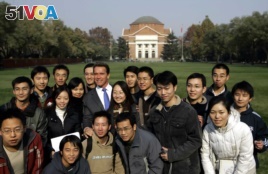29 September, 2017
Western countries again top Reuters' yearly list of the World's Most Innovative Universities. The media group ranks educational centers based on scientific gains, invention of new technologies and success in new markets and industries.
Reuters says Asian countries will definitely be a powerful force in the future world economy. But, it says Western countries still produce the most influential research leading to the most useful technologies.
This year's top 100
Stanford University is number one on Reuters' list for the third straight year. The private school is found in the heart of California's Silicon Valley, and not by chance. The university played a big part in creating the area. Stanford is known for leading technology development, especially related to the internet.
It was a Stanford professor who designed the internet's basic communication system. In addition, former Stanford students have founded some of the biggest tech companies in the world, including Google, Intel, Hewlett-Packard and Netflix.
Other results from this year's list
The top ten on the list is much the same as last year. Nine universities return to the highest positions. Most are large, well-established universities located in the United States.
The second and third highest-ranked schools are MIT and Harvard. Like Stanford, they have also held the same ranking for the past three years. In fourth place is the University of Pennsylvania, which climbed four spots from number eight last year.
Two of the top ten are outside the U.S. Belgium's KU Leuven comes at number five. The almost 600-year-old university is one of the largest independent research and development organizations on the planet.
A South Korean university, KAIST, comes next. The South Korean government established the school in 1971. Officials modeled KAIST after engineering schools in the United States. Most classes are taught in English. And, the United States Agency for International Development provided a multimillion-dollar loan to help get KAIST started.
The top 100 positions on the list are filled by 51 universities in North America, 26 in Europe, 20 in Asia and three in the Middle East.
The fall and rise of Asian institutions

FILE - Former California Gov. Arnold Schwarzenegger poses for a group photo with students during a visit to Tsinghua University in Beijing Wednesday Nov. 16, 2005.
Why are there so few Asian universities on the list? One reason is because Japanese universities, traditionally the strongest research schools in Asia, depend heavily on government support. Japan's economic growth has slowed over the last 20 years, providing less money for research as a result.
The index service Web of Science found a recent drop in publication of Japanese research. The organization says Japanese researchers were responsible for 8.4% of all scientific papers published in 2005. In 2015, the percentage had dropped to 5.2%.
Reuters' 2017 rankings reflect that decline in research and development. The University of Tokyo, for example, fell five places to number 21 on the list. Osaka University is now number 24. Last year it was 11th. And, Keio University went from 53rd in 2016 to 78th this year.
Kyushu University, at 68th place, was Japan's only school to rise on the list. Last year, it ranked 79th.
China's representation on the list has grown. In 2015, only one Chinese university was ranked. Last year, two made it. Now there are three.
The two Chinese universities returning to the list also saw their positions rise. Tsinghua University climbed 15 spots to number 51 and Peking University went from 70th to 60th.
Zhejiang University appears on the list for the first time at number 100.
Creating the list
The 100 schools were chosen after examining each candidate on different metrics, including academic papers and patent filings. They were ranked based on their performance.
The ranking system groups all departments in a university together. This means extremely innovative individual departments or programs could be overlooked. And, remember, even the lowest ranked university on Reuters is a member of a highly exclusive group.
I'm Phil Dierking.
David Ewalt wrote this story for Reuters. Phil Dierking adapted this story for VOA Learning English. Mario Ritter was the editor.
Are any universities from your country on this list? We want to hear from you. Write to us in the Comments Section or on 51VOA.COM.
______________________________________________________________
Words in This Story
academia - n. the life, community, or world of teachers, schools, and education
data - n. facts or information used usually to calculate, analyze, or plan something
innovate - v. to do something in a new way
metrics - n. a method of measuring something or the results from the method
patent - n. an official document that gives a person or company the right to be the only one that makes or sells a product for a certain period of time